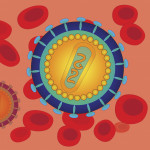Scientists have discovered key biological differences that may explain why some primates don’t get sick despite being infected with simian immunodeficiency virus (SIV)—a virus almost identical to HIV—according to a Nature Medicine study reported by Science Daily.
As with primates—like chimpanzees and monkeys—and humans, SIV and HIV are genetically very similar. Therefore, by studying the effects of SIV in primates, scientists can learn about HIV and its possible prevention and treatment. For 20 years scientists have known that some SIV-infected primates don’t experience destruction of their immune systems, even though they have high amounts of the virus in their blood. Until now, however, the exact mechanism that allows some primates to remain well despite infection hasn’t been identified.
Mark Feinberg, MD, PhD, formerly of Emory University in Atlanta and now with Merck & Co, and his colleagues studied the activity of a variety of immune system cells in primates that do become ill from SIV, like Rhesus Macaques, and primates that do not, such as Sooty Mangabeys.
Dr. Feinberg’s team found that in SIV-infected Rhesus Macaques, the dendritic cells—immune cells responsible for identifying new infections and mounting an immune response—easily recognize SIV and mount a significant immune response. This is much the way humans respond to HIV.
The dendritic cells in Sooty Mangabeys, on the other hand, have little reaction to the presence of SIV. This blunted immune response is actually a benefit, as it prevents immune cells from being chronically activated, a process that many scientists now believe is responsible for the eventual destruction of the immune system. Thus, Sooty Mangabeys do become infected with SIV, and the virus actively reproduces in their bodies, but they don’t experience disease progression.
Feinberg’s team writes that their study reveals “a great deal about the emergence of the AIDS pandemic, and about the mechanisms underlying AIDS progression in humans. In addition, such insights will hopefully help inform new approaches to treat HIV infection most effectively.”
Advertisement
Advertisement
Advertisement






Comments
Comments